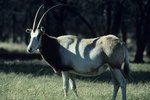A camel's hump stores fat, not water. As he eats and drinks, he builds hump fat reserves that sustain him through lean times. A camel's water intake varies according to his environment, his exertion level and the amount of fat in his hump. A thirsty camel can drink more than 30 gallons of water in less than 15 minutes.
Bactrian and Dromedary Camels
Bactrian camels live in central and eastern Asia; dromedaries, or Arabian camels, live in northern Africa and the Middle East. The two types of camels are distinguished by their humps -- the dromedary has a single large hump, while the Bactrian camel is dual-humped. Though their humps are shaped differently, they function the same way, serving as fat stores to get camels through times of limited resources.
Camel Humps
The number of humps doesn't affect the humps' purpose; both types can hold up to 80 pounds of fat. The humps change as the camels draw upon the fat in their humps for energy if they don't have food to eat or water to drink. As the fat is used, the bactrian camel's humps will lean over and droop. The dromedary's more elastic hump shrinks in size.
Drinking and Eating
The amount of water a camel drinks depends on many things, including the kind of work he's doing, the environmental conditions and how much he currently has in his hump. A very thirsty camel may drink up to 32 gallons of water in approximately 13 minutes. The camel's diet also provides hydration opportunities; when the vegetation the camel eats is higher in water content, such as during colder months, he may forgo drinking because he gets what he needs from green plants.
Tips
If a bactrian camel's humps are flaccid, or a dromedary's is shrunken, the camel is in a deprived nutritional state. A full, firm hump indicates the camel's healthy nutritional state.
Camels eat during the daylight hours, feeding on a variety of vegetation, including tree leaves and branches, bushes, hay, straw, grass and grains. Thorny bushes are no problem for camels, as their thick, tough lips are flexible enough to break off tough branches and durable enough to hold up to sharp ends. As cows do, camels will chew their food, swallow it, regurgitate it back into their mouths and chew it again.
Living on the Hump
Because of the fat stored in his hump, a camel can go several months without food and several weeks without water. Normally weighing between 1,600 and 1,800 pounds, a camel can survive a loss of up to 40 percent of his body weight. A camel can adjust his body temperature to the ambient temperature to help him maintain his hydration level and his urine output.





